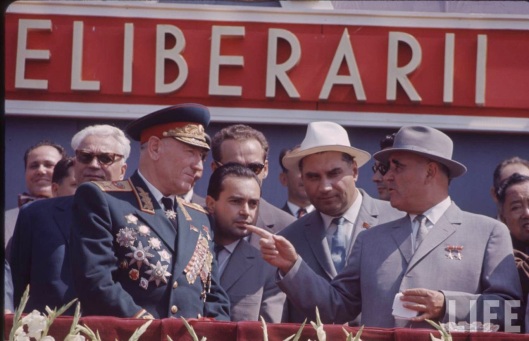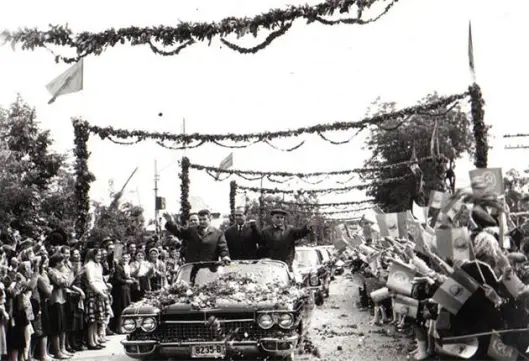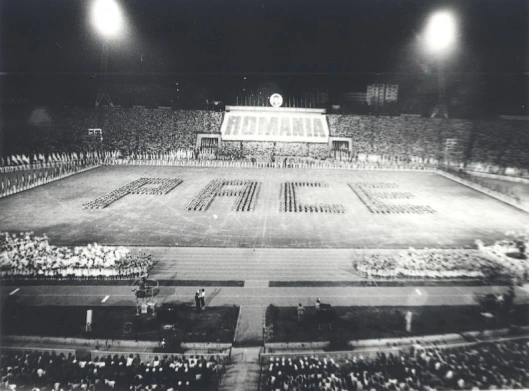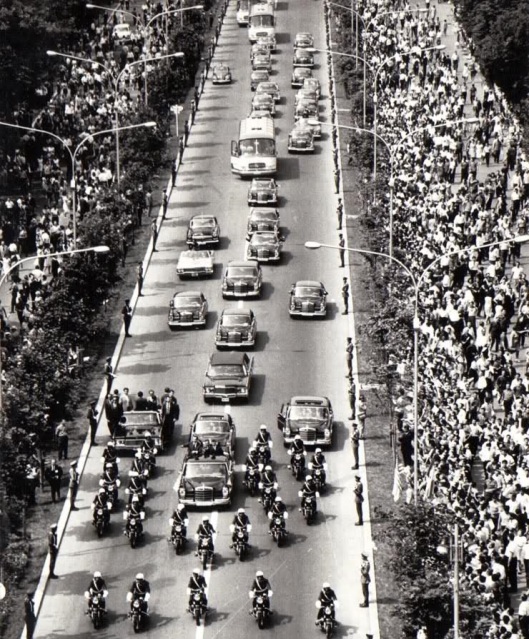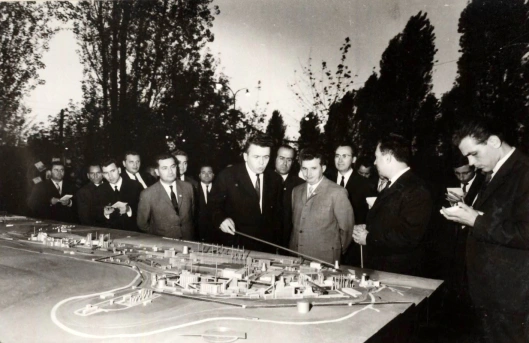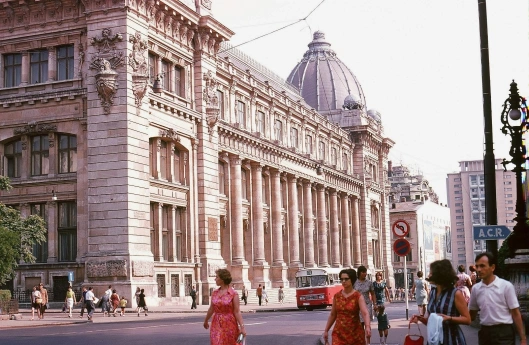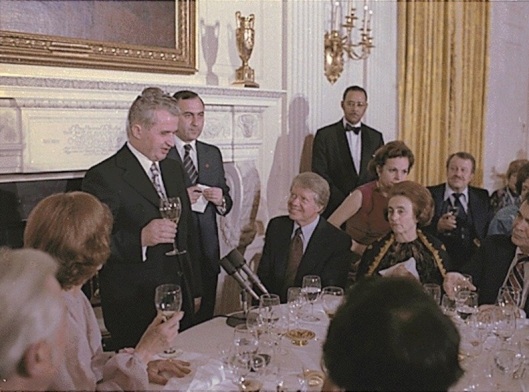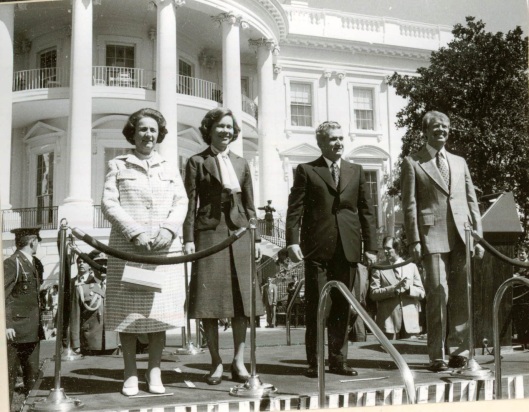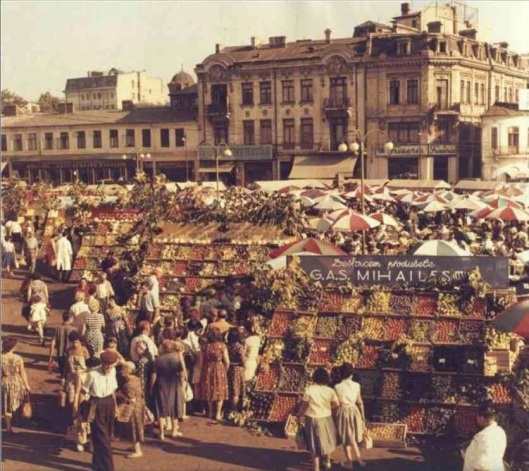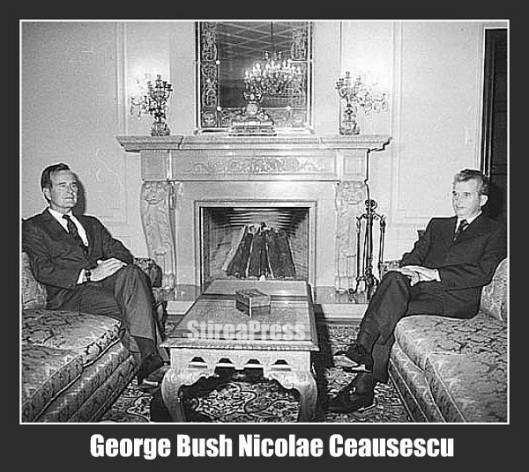Tags
1989, agriculture, communism, communist, eastern europe people, eastern europeans, history, nicolae ceausescu, partisans, romania, romanian people, romanian revolution, world war
SOURCES:
“Sovereign Debt, Austerity, and Regime Change: The Case of Nicolae Ceausescu’s Romania” – by Cornel Ban
“The world economy and the Cold War, 1970–1985” – by Giovanni Arrighi
“Crisis in the Eastern Bloc – Soviet and IMF looting in Romania” – by Executive Intelligence Review
________________________________________
Timeline prior to Ceausescu’s regime – 1944 – 1964
.
Between 1944 -1958, Romania was under Soviet occupation. The Paris Peace Treaty of 1947 provided a legal basis for the Soviet military presence in Romania.
23 august 1944 – King Michael of Romania, in secret collaboration with the Communists and the Allies, overthrows the Antonescu regime. The Red Army advances into Romania. The King was awarded by both US president Truman and Soviet leader Stalin for his role in the coup.
September 1944 – Soviet military occupation of Romania. Despite the armistice, over 200.000 Romanian soldiers are taken prisoners to Siberia and Romania is treated like an occupied enemy territory.
1945 – King Michael appoints pro-Soviet government lead by Petru Groza.

23 august 1945, day celebrated as “liberation from under the fascist stake”. The portraits of Romania’s King Michael, UK prime-minister Attlee, US president Truman and Soviet leader Stalin are at the epicenter of the parade.
– SovRom were Soviet-Romanian joint ventures that redirected all profit and goods from Romanian companies to the Soviet Union as “post-war reparation payments”. SovRom companies were set up in industry, agriculture, transportation and banking system: Sovrompetrol, Sovrommetal, Sovromtransport, Sovromcuart, Sovromtractor, Sovromcarbune, Sovromfilm (used for propaganda), Sovrombanc, Sovromasigurare and others.
According to the Yalta agreement signed by Truman, Churchill and Stalin, the agreement did not imply occupation of eastern Europe countries. A secret documented unearthed in 1981 showcased the directives from Moscow regarding the manner in which occupied countries of eastern Europe shall be treated. The document was elaborated by Laurent Beria, head of the NKVD (today’s KGB), and was released on June 2, 1947.
The directives targeted the destruction of education, health, culture, the intentional impoverishment of regular citizens, destruction of the self-sufficiency of farmers, the creation of an engineered dependency on imports, the liquidation (execution) of citizens who posed a threat to the Soviet presence. The document also mentioned that all government, public administration bodies and factories were to be run by secret agents from Kremlin or by secret collaborators.
Source: Opresiunea cultelor religioase din Romania în timpul dictaturii comuniste, 2002. Quick version of NKVD directives on istoria.md (romanian)
.
By 1952, 85% of Romanian goods went to the Soviet Union without any taxes – however this was presented to the public as “commerce”. Romania was also a source of uranium which was used in the Soviet military industry; the company involved bore the name of Sovromcuart. Work force was provided through political prisoners, of whom there was no shortage in the 1950’s; many suffered and died from uranium radiation.
1946-1947 – The war costs and the Soviet hijacking of the economy lead to a severe crisis – food prices rise up to 1000%.
A Chicago Tribune article dated April 25, 1947 confirms a “famine engineered by the Soviets for political purposes” in Romania. The facts were collected by US journalists who had made their entry into the country illegally – click here for original article.
February 1947 – the Peace Treaty of Paris is signed and the Soviet Union receives the right “to keep on Romanian territory such armed forces as it may need for the maintenance of the lines of communication of the Soviet Army with the Soviet zone of occupation in Austria”. The presence silently assured the installment of communism in Romania and eliminated any opposition. When Austria annulled the terms of the treaty, the Soviet presence on Romanian soil became legally unjustified.
5 March 1948 – The Communist party forces King Michael to abdicate. Monarchy is abolished and the country becomes the People’s Republic of Romania.
– Decree no. 175 is adopted, a new education policy which reduces the compulsory education from 7 years to 4 years. Russian language becomes mandatory. USSR-type educational plans are introduced.

Bucharest building carrying Soviet slogan and symbols – buildings all over the country are forced to carry pro-Soviet slogans: “Long live the Soviet-Romanian friendship”
1949 – The government adopts a massive agrarian reform in the form of collectivization. Given its traditionally strong anti-communist stance, Romania undergoes the harsh Soviet-style collectivization. The process is violent and forceful, and those unwilling to abide by the new law are arrested or shot.
Quotas are introduced and peasants must cease to the state their annual production. 50% of the collection is sent to USSR; the population is severely impoverished.

Bucharest – Casa Presei (House of the Press) built in 1948-1954. Served as headquarters of the pro-Communist media. Lenin’s statue stands in the front.
Uniunea Sovietica (Soviet Union) magazine – romanian version
1950 – A mass-industrialization program begins and rural population is dislocated from villages to new industrial towns in order to provide workforce. Unlike the industrialization of XIX century western Europe where the process of rural relocation to the urban environment was aleatory, the relocation in the communist system was systematic and methodical. However, they both saw the peasant as backward element of the society, and therefore followed the same goals: urban growth, industrial development, extinction of the traditional rural lifestyle and the creation of the proletariat and a new urban culture.
Between 1956-1977, the proportion of the non-agricultural labor force increased from 30% to 60%.

1964 photos by Carl Mydans – the Romanian village underwent total structural transformation with a majority of the rural population being dislocated from its roots. The remaining population was subjected to collectivization which lasted until 1962.
To read more details, see the previous article – The Romanian peasant and agriculture
1955 – To legally justify Soviet military presence in central and eastern Europe, the Warsaw Pact was created – a mutual defense organization that put the Soviets in command of the armed forces of the member states.

Romania – Portraits of Lenin, Karl Marx and Friedrich Engels (pioneers of the Communist movement) dominate the national parades that celebrate Communism and the “liberation from under Fascist rule”.
1956 – The Hungarian Revolution against communist rule takes place. Romanian students and workers react, and protests take place in Bucharest, Iasi, Cluj, Timisoara and Oradea. The cities were immediately placed under military Soviet rule and massive arrests and violent repercussions followed. The West showed no reaction.
1958 – Soviet troops withdraw from Romanian soil.
1961 – The Khrushchev plan presented to members of Comecon divided countries of the Eastern Bloc into a new system of “agrarian” and “industrial” countries, who were going to serve the economic interests of the USSR. Through this plan, Romania was obliged to remain a supplier of raw materials and agricultural products, and to abandon the program of industrialization. This moment represents a turning point in Soviet-Romanian relations, when Romania chooses its national best interest.
1962 – Collectivization is finalized. 90% of the agricultural land fell in the possession of the state and all mechanical equipment was confiscated. The land was reorganized in collective state farms where peasants could work in exchange for a wage or receive shares from the crops they gathered as employees.
1963-1964 – A political liberalization takes place throughout the Eastern Bloc, which includes a political amnesty that which releases political prisoners from prison and cancels their death sentences.
.
Timeline of Ceausescu’s regime
.
Between 1948 and 1963, Romania’s foreign policy had been subservient to Moscow. With the death of Stalin, the countries of eastern Europe saw a wave of political liberalization and Romania’s foreign policy saw a dramatic turn in the 1960’s.
1965 – After leader Gheorghe Gheorghiu-Dej passes away, Ceausescu succeeds to the leadership of Romania’s Communist Party as its first secretary. The country adopts a new Constitution and it is officially renamed the Socialist Republic of Romania. The SovRom companies are liquidated.
Ceausescu initiates a large centrally-planned industrialization process, and chooses domestic liberalization policy and opening toward Western finance, trade, and technology. The chemical industry had a good starting point with the oil and gas industry, which had expanded prior to WW2.
– After the war reparations to USSR come to an end, the battered economy starts to gain momentum. The authorities adopt a mechanization process in agriculture which helps grow the output more than 3 times. Though agriculture represented a strategic advantage for Romania (due to its favorable climate and fertile soil), industrialization was given absolute priority. The percentage of industrial investment per GDP went up from 18% in the 1950’s, to 34% between 1971 and 1975.
1966 – In the Bucharest Declaration, Ceausescu affirms his neutral stance in both the military alliances of the Warsaw Pact and NATO, which in his view divide European countries and create tension. He publicly stands up for a unified pacified Europe without military borders.
– Following the severe post-war economic depression, the birth rate decreased dramatically. Aware that it could hinder future economic growth, the government adopted a pronatalist policy and Ceausescu introduced an abortion ban to stimulate population growth. Abortion was permitted only when a woman was over 38 or had had 4 children already. Families with 5 children or more received special benefits.

The majority rural population was resettled to cities to provide workforce for industry. Given the large fertile cropland in Romania, the harvest season was left with insufficient farm workers. To compensate, the government mobilized soldiers and students in “voluntary seasonal work” which was in fact mandatory unpaid work.

The industrial development required extra-labor force. New apartment facilities were built throughout Romania.

Compared with other communist regimes, Romania maintained a more liberal emigration policy. In the early 1960’s Romanian Jews emigrate en-masse to Israel (as seen in the above photo taken by an American in 1964 in Baneasa airport – Bucharest). The Communist party loses its Jewish members and gains an increasing nationalist tone.

Menachem Begin, Israeli prime-minister visit to Romania. Although the Israeli-Palestinian issue didnt directly concern him, Ceausescu’s stance towards the conflict was of great importance to the Western leaders. Though fully cooperative with Israel in various economic/political issues, Ceausescu firmly supported the withdrawal of the Israeli military from the occupied Palestinian territories.
1967 – Ceausescu assumes presidency of the State Council and becomes Romania’s head of state.
– Romania becomes the first country in the Eastern Bloc to establish diplomatic relations with West Germany.
– Romania, Bulgaria and Yugoslavia register some of the highest economic growth rates in Europe. Up until 1977, Romania’s industrial output registers a growth of 8% per year.

Visit to Bonn, West Germany. Romania was the first country in the Eastern Bloc to establish diplomatic relations with West Germany.
.
Photos of Industrial Romania during the Socialist era of Ceausescu
.
1968 – in May, Law no.11 regarding education is adopted. Access to education is made free for all categories regardless of nationality, race, age or religion. Compulsory education is reversed from 4 years to 7 years. The law specifically mentions the shortcomings of the 1948 education policy.

“Pace” (english: peace) – the idea of peace was heavily ingrained in civic culture from an young age, ever-present in schools, national anthems, media etc.
– experts from the IMF and World Bank visit Bucharest to present to Ceausescu the advantages of cooperation with their institutions.

The Pioneers – youth association which educated young people in the spirit of socialism. Basically all students over the age of 14 were members.
.
The Prague Spring
.
August 1968 – the Prague Spring in Czechoslovakia prompts Soviet military intervention. Ceausescu refuses to participate in the military invasion of Czechoslovakia and publicly condemns it, ending Romania’s active participation in the Warsaw Pact military alliance.
Ceausescu against the Soviet invasion of Czechoslovakia
Romania grows increasingly estranged from Moscow and becomes the first Warsaw Pact country to sign a trade agreement with the European Economic Community. Romania exports to both Western and Eastern markets.
Nicolae Ceausescu at the General European Conference – 1968
.
1969 – US president Richard Nixon visits Bucharest and ensures Romania of political and economic support. He was the first US president to visit a Communist country.
1972 – The international financial institutions and leaders of the “Free World” poured praise on Ceausescu’s regime for the swift pace of economic modernization. The Bretton Woods institutions (the IMF and WB) offer loans to Romania on generous terms (annual interest rate of 0.5%). After 5 years of diplomacy and technical talks, Romania becomes member of the IMF but it has yet to sign an agreement. It is given “preferential trading status”.
.
Ceausescu established diplomatic relations with countries all around the world, visiting in total over 100 countries. Central Africa, a region rich in natural resources such as diamonds, but without facilities to exploit them (a common issue in Africa) was on his list
.
.
.
.
1973 – First oil shock – Iran crisis. Romania was not affected by it, as it was able to cover its needs from local oil fields (Romania enjoys consistent oil resources).
1975 – Romania receives the US Most-Favored-Nation tariff status. Both Western and Eastern leaders agree that industrialization was the main engine of economic modernization, and World Bank signs 2 stand-by arrangements with Romania to support the industrialization program.

US president Gerald Ford visit to Bucharest to ratify the trade agreements between the US and Romania.
Although the World Bank’s role was to fund infrastructure development, it changed its objective and fund large industrial projects as well, which involved risks for the borrowing country (oil prices, dependency on technologies etc).
.
In the words of Giovanni Arrighi, during the 1970’s countries of Eastern Europe, Latin American and Africa – totaling over 100 countries – were lured into borrowing from the “magic liquidity machine” represented by western international banks from highly-industrialized countries.
Eastern European countries received loans for industrial development and acquisition of technology. Other countries received loans for various development programs.
Eager to develop heavy industry, which automatically increased the oil consumption, Ceausescu developed relations with Middle Eastern oil-rich countries in order to diminish oil dependency on the USSR. In the video – state visit to Iran.
.
The industrial development left a vulnerability through increased dependency on oil, which in the case of a new oil crisis, would create an economic problem. In order to avoid the long-term oil import dependency and a possible oil crisis, Romania invested in more local oil refineries.
The Western loans were made at low interest rates. An energy-intensive economic structure was developed – steel, petrochemicals, engineering, manufacturing, which also made Romania dependent on oil. Western technology is transferred in local industries through Romanian–West German, Romanian–French, and Romanian–British joint ventures. Additional resources are needed outside local oil production and Ceausescu invests in expanding Romania’s oil-refining capacity.
.
The IMF and World Bank
.
After WWII, the US created international institutions, whose legitimacy was built on the concept that “the security of the world has to be based on American power exercised through international systems”. The institutions were the United Nations, the International Monetary Fund (IMF), the World Bank (WB), the General Agreement on Tariffs and Trad (today’s World Trade Organization).
The IMF and World Bank are two sister institutions created at the Bretton Woods conference in 1944 and are both based in Washington. Their initial purpose was post-WW2 reconstruction in Europe. In the following decades, their objective stretched from post-war reconstruction to “global growth” through the promotion of liberal economic policies, based on the belief that they were the only viable option for a stable world economy.

US corporate magnate/ banker David Rockefeller and Nicolae Ceausescu
The World Bank funds development programs, while the IMF regulates balance of payments when countries are in economic difficulty and cannot repay foreign debt. The IMF objectives are: promotion of international monetary and trade cooperation, high employment, exchange-rate stability, sustainable economic growth.
Both the IMF and World Bank impose severe austerity programs (SAP) with the loans, which involve: cuts in health, education and pensions; devaluation of national currency (which raises the cost of foreign exchange); privatization of public enterprises and services; high interest rates (which raise the cost of credit); wage guidelines (reduce the price of local labor to create cheap labor).
Romania’s post-war Soviet occupation brought damning conditions imposed by Moscow (see below – NKVD directives). More conditions were later imposed by the IMF: cuts in education, health, culture and other social sectors, the destruction of the small farmer and the local market, the dismantling of local factories and an engineered raise of imports.

The IMF assumes that cutbacks in government spending and lowering labor prices will attract private investment.
.
In the early 1970’s, eastern European countries received Western loans at fixed exchange rates. When the interest rates were suddenly increased by the US in 1979, a large debt was created. The debt repayment was assisted by the IMF, who imposed tough austerity programs.
The widespread financial crisis began in Eastern Europe, then in Latin America and finally in the rest of the developing world, all of whom had been flooded with foreign credit in the 1970’s. The social and economic crisis created in the early 1980’s Eastern Europe was the motor for the revolutions of the late 1980’s. The borrowing countries remain stuck in perpetual debt.
Ceausescu and Queen Elizabeth outside Buckingham Palace
_______________________________
.

Romania was producer and exporter of steel, refined petroleum products, machine tools, locomotives and rolling stock, oil-field equipment, offshore-drilling rigs, aircraft and other manufactured goods.
March 1977 – Major earthquake in S-E Romania. Over 1.500 people die, 90% of the victims being registered in Bucharest.
Between 1950 and 1977, the industrial output had registered an annual 8% growth. In 1977, industrial production is halted temporarily due to the severity of the earthquake.
After the disaster, the Romanian government imposed tougher construction standards.
1979 – Romania undergoes two shocks: American monetary policy change and the Iran oil shock.
MONETARY POLICY CHANGES MADE BY THE US. On October 6 1979, the US famously reversed its monetary policy. The Federal Reserve adopted new policy procedures that led to skyrocketing interest rates and two recessions, but which also brought general economic stability in the US for the next 2 decades. All countries with international loans were pushed into default and economic recession: a widespread financial crisis started in Eastern Europe, Latin America and the rest of the developing world – all of whom had made Western loans.
The $46 billion inflow of 1970’s became a $347 billion outflow in the 1980’s. In other words, western credit banks were set to receive back 5 times more than they had loaned to various countries. The borrowing countries defaulted on their debt (unable to pay).
Since 1979, the US enjoyed enormous capital flows from poor and middling borrowing countries who had suddenly become heavily indebted.
THE IRAN OIL SHOCK – Romania is affected by oil prices since by now, it had an enlarged industry with increased oil dependency from the Middle East and its own local enlarged oil refineries had not been finalized. However, the main factor that threw Romania into heavy foreign debt were the increased interest rates made by the US.
1977 – 1981: Romania’s foreign debt goes up from $0.5 billion to $10 billion following the 1979 US increase of interest rates. Dozens of countries around the world who had been offered Western loans go into default.
1980 – The US nominates World Bank top chiefs who bring in new ideological focus. The new ideology pushes indebted countries to comply with structural adjustment programs (SAP) in order to repay their debt.
SAP is a controversial program that involves cutbacks in health, education and social care, growing exports, removal of price controls and state subsidies that protect local business, devaluation of national currency (which leads to more expensive foreign products). These steps increase poverty, affect the long-term course of a national economy and lead to social unrest.
From this point onward, the conditional loans allow bank involvement in government policy, which affects the political and economic sovereignty of nations.
1981 – Ceausescu meets with creditors to agree on new terms to reschedule the debt payments. Romania is obliged to request International Monetary Fund lines of credit in order to meet its debt obligations.
The debt creditors included the Paris Club, a secretive cartel organization made up of world elite who offer no transparency about their actions (source).
On June 15 1981, a new loan is offered by the IMF but only after it imposes certain austerity conditions: rise gas and food prices, reduce industrialization, provide more information on the economy.
According to Ceausescu’s financial counselor, the negotiations were long and complex, with the Romanian side trying to make compromises in order to avoid currency devaluation and cuts in education, health and the minimum wage.
From this point onward, for almost a decade Romanian industry was virtually unable to bring in new technology.
November 1981: IMF cuts off the promised loans due to austerity measures not being fully met in Romania.
– Poland, in similar situation, requests new rescheduling of the debt with creditor banks. Though the situation was urgent, creditors prolonged the negotiations for more than a year, during which the hardship boiled over into total economic collapse which lead to social unrest and chaos in Poland. As a response, martial law was declared in Poland. The US cut ties with Poland on the basis of human rights abuse, and the debt situation and economic crisis are left in limbo. The social and economic situation in countries of eastern Europe worsens.
The CIA and foreign intelligence infiltrate to support revolutions and destabilize local governments in the Eastern Bloc (see here and here). The following documentary shows how agents provocateurs and criminal elements were used to create false flags dramatically covered by Western media against the Romanian government in order to bring it down, regardless of the risk of peace or safety to civilians.
“Checkmate – Strategy of a Revolution” award-winning 2003 German documentary which reveals foreign intelligence infiltration in 1980’s Romania in order to plant the seeds of revolution
.
SOVEREIGN DEBT
1982 – Romania goes into default for the first time in 50 years (the last time being in 1932 during the Great World Depression).
With the Romanian government trying to avoid currency devaluation and refusing to make cuts in government spending, its left with the option of raising exports. On the requests of the IMF, imports were reduced and exports were increased in industrial and agricultural products. After this measure was implemented, the IMF released the last tranche of loans.
* Since 1981, Romania had been a net importer of food from the West. In the same year, Soviet statistics show that Romania exported 100.000 tons of frozen meat to the Soviet Union. Cutting back on food imports, while at the same time continuing to export meat, forced Ceausescu to introduce meat rationing.
.
– after the last IMF tranche is released, Ceausescu decides to pay off the debt earlier in order to avoid future financial traps. He sees industrial development as the only hope for economic revival and continues to support investment in industry. Since heavy industry was dependent on oil and its growing size outstripped the country’s oil capacity, drastic energy saving measures were introduced.
.
1986 – Domestic situation worsens. The industrial labor force is faced with a reduced supply of food and other consumer goods. Romania starts exporting domestic output as well in exchange for foreign currency; the revenues were then used to repay foreign debts early and as rapidly as possible.
1987 – Due to the severe consequences of the last IMF agreement, Ceausescu concludes that debt-financed development was not a viable option on the long-term and chooses disengagement with Western finance capital (any future foreign loans are forbidden by law).
At the same time, strikes begin across the country and the idea of mass mobilization against wage cuts and consumption deprivation is born. The social upheaval is secretly supported by the CIA.
1988 – After the Annual Meeting of the Boards of Governors (World Bank), Ceausescu revokes Romania’s Most-Favored Nation Status received in 1975 from the US.
Declaration from Romania’s representative Dumitru Paraschiv at the Annual Meeting – World Bank (source)
“Protectionism and the discriminatory barriers in world trade have intensified. The developing countries’ access to contemporary scientific and technical progress has been restricted even more. Economic constraints arising from political factors have been imposed. World economic instability has increased. The external debt burden has grown and is having a greater negative impact on economic growth in the developing countries.
The developed countries have continued to use excessively high interest rates, exchange rate volatility as instruments for casting the difficulties imposed by economic crises onto the shoulders of borrowers.
We are now in a paradoxical situation in which capital flows are reversed, moving from the developing to the developed countries, a situation which should be brought to an end. Instead of extending substantial and effective support to the developing countries, particularly to those facing serious problems with their external debt, the IMF and the IBRD (World Bank) have in many cases aligned themselves with the policy pursued by the commercial banks, especially with regard to lending and repayment practices, including the exchange rate level, at the expense of the developing countries.
All of these are wiping out the developing countries’ efforts aimed at carrying out their programs of economic growth and paying back their external debts, leaving a situation which is virtually beyond their control.
As a member country of the International Monetary Fund and the World Bank, Romania is concerned with the way in which these international organizations participate in the solution of the problems currently affecting the world economy, and first and foremost the economies of the developing countries. These two institutions, created to support the economic growth of the developing countries, have not always succeeded in meeting these requirements. This is evidenced by more and more inequitable and undemocratic practices, by the plundering of the economies of the developing countries, and by subjecting the supply of credit to conditions through the imposition of programs, which effectively constitute interference in the domestic affairs of the developing countries and bring about inflation and declines in living standards, and thus amount to violations of the institutions’ statutory obligations.
In practice, the Fund and the Bank have acted in favor of the rich countries and against the interests of the developing countries. In the opinion of President Nicolae Ceausescu, these institutions must ensure an increase in capital flows on concessional terms to the developing countries without imposing economic and financial conditions and without interfering in their domestic affairs.”
April 1989 – The final payment was made to the IMF and the foreign debt was extinguished.
Speech by Ceausescu on July 15, 1989 (english subtitles)
.
“I want to emphasize the importance of the conference of the Political Consultative Committee – the socialist states participating in the Warsaw Treaty, which took place a week ago in Bucharest.
We have paid attention to this Conference and the problems of the world economy, and particularly of the situation in developing countries.
This is because, currently, the situation in developing countries is particularly severe. More than 4 billion people live in poverty, and in this decade, their situation has continued to worsen, while rich countries, and in this course, a small group of the wealthy elite have accumulated annually tens of billions of dollars from these developing countries.
Capitalism has died in Romania. The people are the true master, and will forever remain the master of their destiny and of their country’s riches.”
August 1989 – The last major project was the Bucharest subway system, started in 1976. The last section is opened in August.
December 1989 – Starting with December 22, over 1.000 people are shot dead throughout the country, most of the victims registered in Bucharest. Ceausescu and his wife are executed on Christmas day after a one hour show trial. The accusations were genocide of 60.000 people during the Revolution (later proved to be false) and undermining the national economy.
According to Sean Gervasi (former Kennedy advisor and expert in Yugloslav affairs), secret documents declassified after 1990 show that in 1982 the U.S. drew up National Security Decision Directive (NSDD) 54, “United States Policy toward Eastern Europe.” Labeled SECRET, it called for efforts to promote a “quiet revolution” to overthrow Communist governments and parties, while reintegrating the countries of Eastern Europe into a market-oriented world economy.
Romanian Revolution summarized by Susanne Brandstätter reveals foreign involvement
.
The tensions between Hungarian/ Romanian minorities were awakened by foreign intelligence in similar manner in which the ethnic tensions were used in Yugoslavia to spark conflict. However, the motor of the revolution remained the decrease in quality of life which was entirely blamed on Ceausescu’s policies. The worst case scenario caught shape in Yugoslavia, whose economic hardship coupled with ethnic tensions blew up into the all-out war of the 1990’s.
Romanian revolution report – interviews from those directly involved in the events of 1989 reveal “what really happened”

UK media. Sensational numbers of victims are used, later proved to be wrong. The media refers to Romania as “one of Europe’s richest agricultural countries turned into one the poorest by the industrial boom”, contradicting its own standard view of industrial countries as developed nations. The prior 1970’s Western media considered Romania a poor backward agricultural country turned prosperous by industrial development proudly assisted by additional Western loans.
In March 1991, the new Romanian government signed a new stand-by agreement with the IMF – with the conditions of beginning free market reforms and lifting all foreign exchange restrictions. The conditions were so severe that it was called the Shock Therapy. These conditions were supposed “to build the pillars of a market economy”.
Unlike the Ceausescu regime, the new leadership implemented all the IMF measures which implied:
– privatization of public sector enterprises, such as utility companies and public services.
– financial liberalization designed to remove restrictions on the flow of international capital in and out of the country, and the removal of restrictions on what foreign corporations and banks can buy.
– removal of state subsides for all state-owned industries and agriculture.
– reduction of the minimum wage, which supposedly attracts foreign investors.
– cuts in spending on education, health and pensions.
Recipe for disaster
The shock therapy was applied to all former Eastern Bloc states in the 1990’s, after which they were hit by severe economic crisis.
Following currency devaluation prescribed by the IMF, economies imploded into hyperinflation. Through privatization/ liquidation, the Romanian national industry has gone into flat line. After massive privatization/ liquidation, the numbers of the unemployed grew faster than the private sector could absorb. Through IMF wage guidelines (to freeze or decrease the minimum wage), multinational corporations gained access to cheaper labor markets and natural resources. Local producers were unable to compete with the better-equipped foreign investors, and the removal of state subsidies (prescribed by the IMF) left them unable to function. The economic crisis caused Romanian birth rate to decrease to record levels, never before seen in Romania’s history.
A 3-hour compilation of rare footage material showcasing Ceausescu’s period 1965-1989. It starts with his predecessors’ death Gheorghe Gheorghiu-Dej and ends with his execution (English subtitles)
https://dailymotion.com/video/x1kftsq
.









